大学实用翻译教程第四章 词语翻译的技巧共66页文档
- 格式:ppt
- 大小:337.00 KB
- 文档页数:66
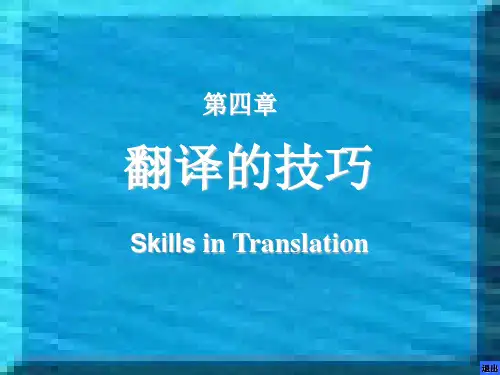
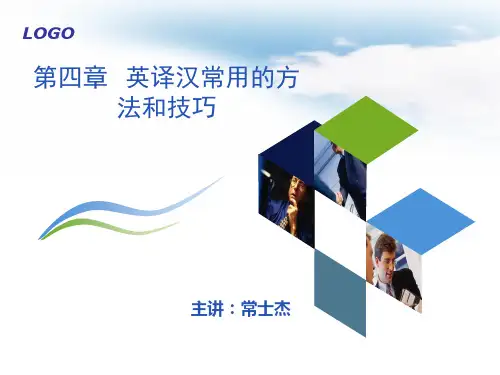
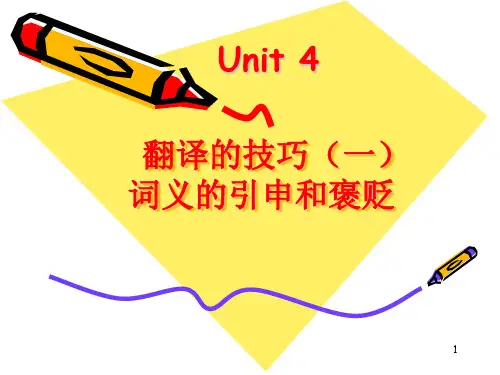
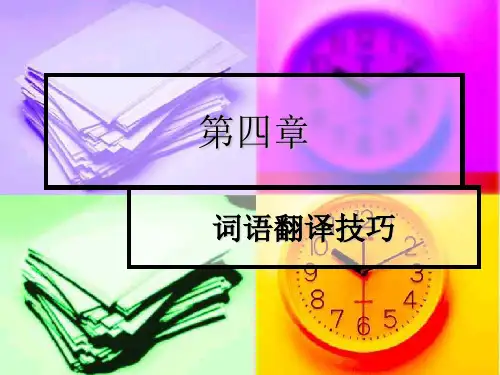
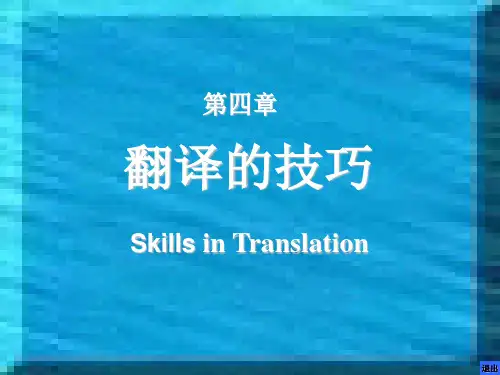
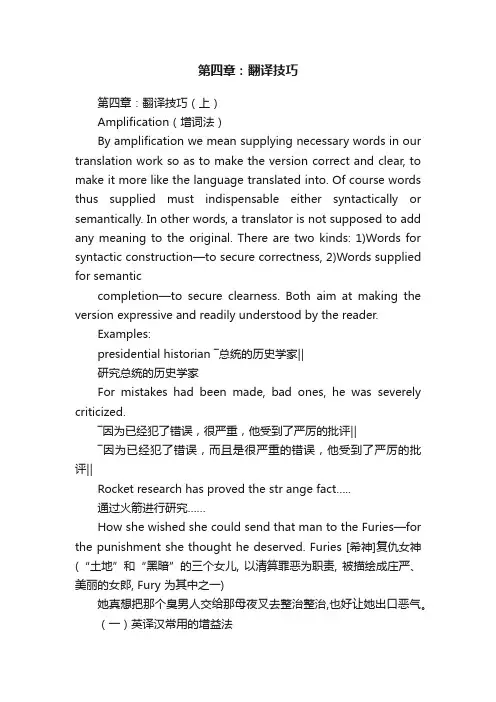
第四章:翻译技巧第四章:翻译技巧(上)Amplification(增词法)By amplification we mean supplying necessary words in our translation work so as to make the version correct and clear, to make it more like the language translated into. Of course words thus supplied must indispensable either syntactically or semantically. In other words, a translator is not supposed to add any meaning to the original. There are two kinds: 1)Words for syntactic construction—to secure correctness, 2)Words supplied for semanticcompletion—to secure clearness. Both aim at making the version expressive and readily understood by the reader.Examples:presidential historian ―总统的历史学家‖研究总统的历史学家For mistakes had been made, bad ones, he was severely criticized.―因为已经犯了错误,很严重,他受到了严厉的批评‖―因为已经犯了错误,而且是很严重的错误,他受到了严厉的批评‖Rocket research has proved the str ange fact…..通过火箭进行研究……How she wished she could send that man to the Furies—for the punishment she thought he deserved. Furies [希神]复仇女神(“土地”和“黑暗”的三个女儿, 以清算罪恶为职责, 被描绘成庄严、美丽的女郎, Fury 为其中之一)她真想把那个臭男人交给那母夜叉去整治整治,也好让她出口恶气。
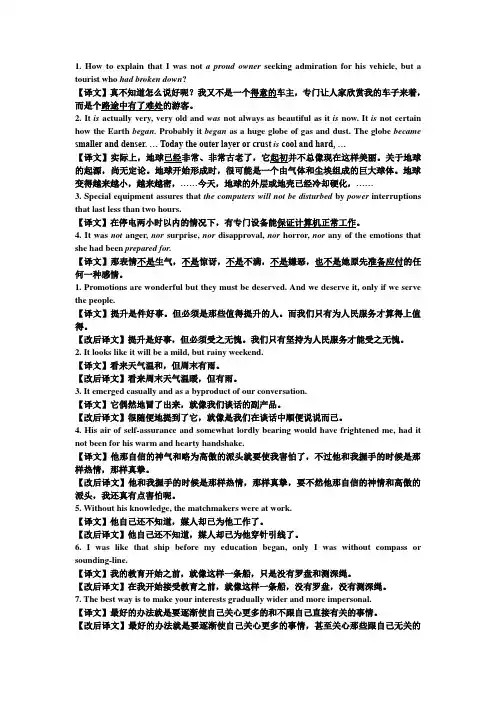
1. How to explain that I was not a proud owner seeking admiration for his vehicle, but a tourist who had broken down?【译文】真不知道怎么说好呢?我又不是一个得意的车主,专门让人家欣赏我的车子来着,而是个路途中有了难处的游客。
2. It is actually very, very old and was not always as beautiful as it is now. It is not certain how the Earth began. Probably it began as a huge globe of gas and dust. The globe became smaller and denser. … Today the outer layer or crust is cool and hard, …【译文】实际上,地球已经非常、非常古老了,它起初并不总像现在这样美丽。
关于地球的起源,尚无定论。
地球开始形成时,很可能是一个由气体和尘埃组成的巨大球体。
地球变得越来越小,越来越密,……今天,地球的外层或地壳已经冷却硬化,……3. Special equipment assures that the computers will not be disturbed by power interruptions that last less than two hours.【译文】在停电两小时以内的情况下,有专门设备能保证计算机正常工作。
4. It was not anger, nor surprise, nor disapproval, nor horror, nor any of the emotions that she had been prepared for.【译文】那表情不是生气,不是惊讶,不是不满,不是嫌恶,也不是她原先准备应付的任何一种感情。
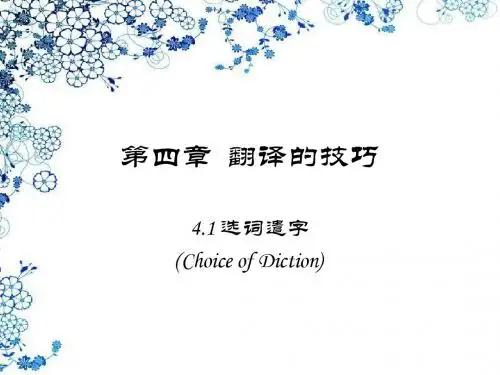
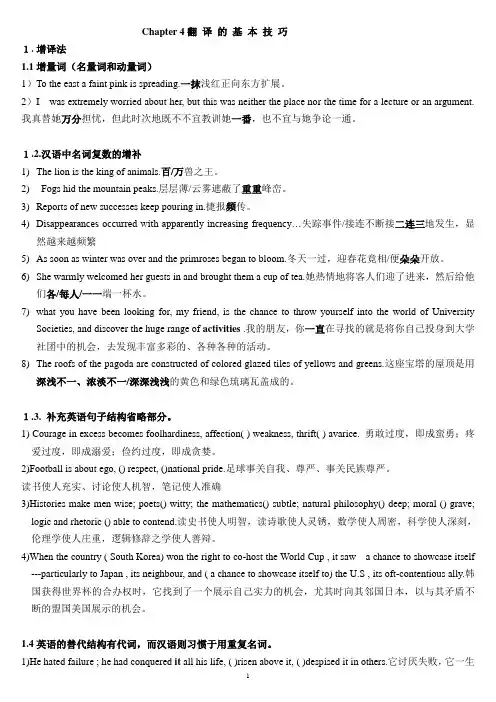
Chapter 4翻译的基本技巧1.增译法1.1增量词(名量词和动量词)1)To the east a faint pink is spreading.一抹浅红正向东方扩展。
2)I was extremely worried about her, but this was neither the place nor the time for a lecture or an argument.我真替她万分担忧,但此时次地既不不宜教训她一番,也不宜与她争论一通。
1.2.汉语中名词复数的增补1)The lion is the king of animals.百/万兽之王。
2)Fogs hid the mountain peaks.层层薄/云雾遮蔽了重重峰峦。
3)Reports of new successes keep pouring in.捷报频传。
4)Disappearances occurred with apparently increasing frequency…失踪事件/接连不断接二连三地发生,显然越来越频繁5)As soon as winter was over and the primroses began to bloom.冬天一过,迎春花竟相/便朵朵开放。
6)She warmly welcomed her guests in and brought them a cup of tea.她热情地将客人们迎了进来,然后给他们各/每人/一一端一杯水。
7)what you have been looking for, my friend, is the chance to throw yourself into the world of UniversitySocieties, and discover the huge range of activities .我的朋友,你一直在寻找的就是将你自己投身到大学社团中的机会,去发现丰富多彩的、各种各种的活动。
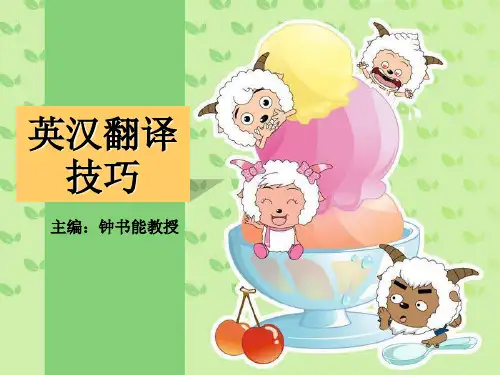
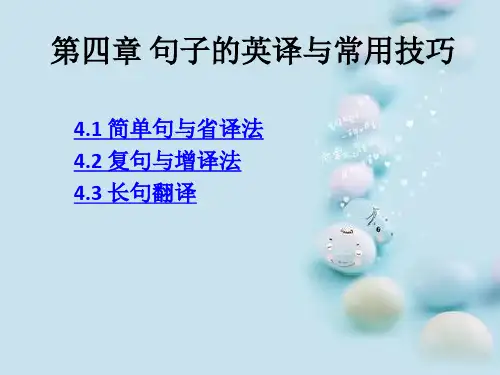
第4章Unit 4 Economy1. 经济文章选篇。
其特点是:着重说明经济形势,提出主张和建议,以大量数据说明问题。
所用语言视场合而定,文件的语言正式而精练,演讲的语言则要比较易于上口。
2. 语言对比:(1)经济术语。
经济领域有大量的专门术语。
如:two way trade双向贸易l ucrative export markets 获利的出口市场foreign exchange 外汇commercial opportunities商业机会export opportunities 出口机会potential exports潜在市场(2)有些普通词语在经济文章中有特殊含义。
经济术语有特殊的用法和搭配。
例1)The result, I believe, is that we have built the beginnings of a sound foundation for future commercial and financial ties.我相信我们已经为今后贸易与金融关系初步打下了坚实的基础。
例2)There are more than 20 joint ventures between the US and Chinese investors.现在有20多家中美合资企业。
(3)数字及有关的术语和量词。
数字很容易出错,因此要特别仔细核对。
和数字有关的动词、介词、形容词、副词也很重要。
如“增加了”和“增加”表示的意思是不一样的。
by用来表示增加或减少的幅度。
表示倍数时汉语与英语不一样。
汉语:1)甲比乙...(形容词或副词)n倍:不包括基数。
2)甲是乙n倍:包括基数。
英语:1) "n+ times + adj.比较级+than"式:包括基数;2) "n+ times + as + adj. + as"式:包括基数;3) "verb (e.g. increase, grow, rise, be raised, etc.) + n + times"式:包括基数。
第四章词汇翻译技巧(上)正因为英汉词汇之间有很多差异,因此词汇翻译不可能达到一一对应的程度,必须掌握一定的词汇翻译技巧,从而使译文在忠实于原文的同时,达到“通顺”的标准。
词汇翻译的技巧很多,归纳起来主要有移植法、增减法、词汇转类法、反译法、分译法和释译法等。
4.1 移植法:在译文中直接借用原文词语。
移植分为直接移植和音译两种情况一、直接移植:将原文中的词语原封不动地挪用过来,多应用于科技翻译和新闻媒体中。
例如:1 )KTV; DISCO; IQ; EQ; AQ二、音译transliterate用一种语言文字写出或读出另一种语言的词和词组的发音。
音译适用以下范围:(一)几乎所用的人名。
例如:Lincoln (林肯);Churchill (丘吉尔);Haughton (霍顿);Shakespeare (莎士比亚);Rambo (兰博);曹雪芹(Cao Xueqin );鲁迅(Lu Xun );钱钟书(Qian Zhongshu )(二)大多数地名。
例如:Australia (澳大利亚);New York (纽约);Atlanta (亚特兰大);Miami (迈阿密);泰安(Taian );山东(Shandong );注意: 港澳台地区与我国对国外人名地名翻译区别。
例如:Reagon (雷根);Kennedy (甘乃迪);Bush (布希);Sydney (雪梨);New Zealand (纽西兰);Hollywood (荷里活)(三)译入语原来没有的事物,包括科技新词、某些商标与文化词等。
例如:Dink (丁克);Yippie (雅皮士);Hippie (嬉皮士);Sauna (桑那);Shock (therapy) (休克疗法);金华(火腿)(JINHUA );麻将(mahjong );磕头(kowtow );功夫(kungfu );茅台(Maotai );阴阳(yin yang );饺子(jiaozi )有时音译比意译要显得形象, 如:’talk show’音译为“脱口秀”,而不译成“访谈节目”;“download”, “modem”不过,音译往往是不得已而为之,音译过来的东西往往无法从字面上看出其内涵,有时会使译文读者产生文化隔阂,导致理解上的困难。